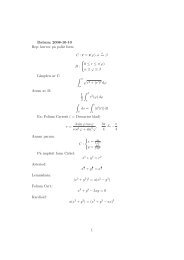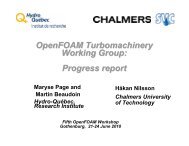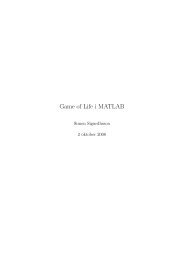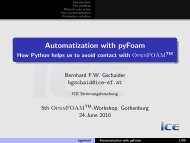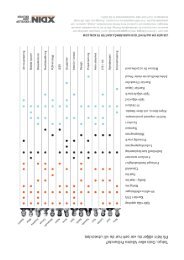Running OpenFOAM in parallel
Running OpenFOAM in parallel
Running OpenFOAM in parallel
You also want an ePaper? Increase the reach of your titles
YUMPU automatically turns print PDFs into web optimized ePapers that Google loves.
POLITECNICO DI MILANO<br />
<strong>Runn<strong>in</strong>g</strong> <strong>OpenFOAM</strong> <strong>in</strong> <strong>parallel</strong><br />
Tommaso Lucch<strong>in</strong>i<br />
Department of Energy<br />
Politecnico di Milano<br />
Tommaso Lucch<strong>in</strong>i/ <strong>Runn<strong>in</strong>g</strong> <strong>OpenFOAM</strong> <strong>in</strong> <strong>parallel</strong>
POLITECNICO DI MILANO<br />
<strong>Runn<strong>in</strong>g</strong> <strong>in</strong> <strong>parallel</strong><br />
• The method of <strong>parallel</strong> comput<strong>in</strong>g used by <strong>OpenFOAM</strong> is known as doma<strong>in</strong><br />
decomposition, <strong>in</strong> which the geometry and associated fields are broken <strong>in</strong>to<br />
pieces and allocated to separate processors for solution.<br />
• The first step is to decompose the doma<strong>in</strong> us<strong>in</strong>g the decomposePar utility.<br />
• The user must edit the dictionary associated with decomposePar named<br />
decomposeParDict which is located <strong>in</strong> the system directory of the case.<br />
• The first entry is numberOfSubdoma<strong>in</strong>s which specifies the number of<br />
sub-doma<strong>in</strong>s <strong>in</strong>to which the case will be decomposed, usually correspond<strong>in</strong>g to<br />
the number of processors available for the case.<br />
• The <strong>parallel</strong> runn<strong>in</strong>g uses the public doma<strong>in</strong> openMPI implementation of the<br />
standard message pass<strong>in</strong>g <strong>in</strong>terface (MPI).<br />
• The process of <strong>parallel</strong> computation <strong>in</strong>volves: decomposition of mesh and fields;<br />
runn<strong>in</strong>g the application <strong>in</strong> <strong>parallel</strong>; and, post-process<strong>in</strong>g the decomposed case.<br />
Tommaso Lucch<strong>in</strong>i/ <strong>Runn<strong>in</strong>g</strong> <strong>OpenFOAM</strong> <strong>in</strong> <strong>parallel</strong>
POLITECNICO DI MILANO<br />
<strong>Runn<strong>in</strong>g</strong> <strong>in</strong> <strong>parallel</strong><br />
• We shall use the pitzDaily case for the simpleFoam application tutorial:<br />
tut<br />
cd simpleFoam<br />
cd pitzDaily<br />
• We can copy the pitzDaily case to the pitzDailyParallel:<br />
cp -r pitzDaily $FOAM_RUN/pitzDailyParallel<br />
• And copy <strong>in</strong>to the system directory the decomposeParDict file available <strong>in</strong> the<br />
pitzdailtExptInlet case:<br />
cp pitzDailyExptInlet/system/decomposeParDict pitzDailyParallel/sys<br />
Tommaso Lucch<strong>in</strong>i/ <strong>Runn<strong>in</strong>g</strong> <strong>OpenFOAM</strong> <strong>in</strong> <strong>parallel</strong>
POLITECNICO DI MILANO<br />
<strong>Runn<strong>in</strong>g</strong> <strong>in</strong> <strong>parallel</strong>: doma<strong>in</strong> decomposition<br />
• The mesh and fields are decomposed us<strong>in</strong>g the decomposePar utility.<br />
• The underly<strong>in</strong>g aim is to break up the doma<strong>in</strong> with m<strong>in</strong>imal effort but <strong>in</strong> such a way<br />
to guarantee a fairly economic solution.<br />
• The geometry and fields are broken up accord<strong>in</strong>g to a set of parameters specified<br />
<strong>in</strong> a dictionary named decomposeParDict that must be located <strong>in</strong> the system<br />
directory of the case of <strong>in</strong>terest.<br />
• In the decomposeParDict file the user must set the number of doma<strong>in</strong>s which<br />
the case should be decomposed <strong>in</strong>to: usually it corresponds to the number of<br />
cores available for the calculation:<br />
numberOfSubdoma<strong>in</strong>s 2;<br />
Tommaso Lucch<strong>in</strong>i/ <strong>Runn<strong>in</strong>g</strong> <strong>OpenFOAM</strong> <strong>in</strong> <strong>parallel</strong>
POLITECNICO DI MILANO<br />
<strong>Runn<strong>in</strong>g</strong> <strong>in</strong> <strong>parallel</strong>: doma<strong>in</strong> decomposition<br />
• The user has a choice of four methods of decomposition, specified by the method<br />
keyword.<br />
• For each method there are a set of coefficients specified <strong>in</strong> a sub-dictionary of<br />
decompositionDict, named Coeffs, used to <strong>in</strong>struct the decomposition<br />
process:<br />
method simple/hierarchical/metis/manual;<br />
◮ simple: simple geometric decomposition <strong>in</strong> which the doma<strong>in</strong> is split <strong>in</strong>to pieces by<br />
direction, e.g. 2 pieces <strong>in</strong> the x direction, 1 <strong>in</strong> y etc.<br />
◮ hierarchical: Hierarchical geometric decomposition which is the same as simple except<br />
the user specifies the order <strong>in</strong> which the directional split is done, e.g. first <strong>in</strong> the<br />
y-direction, then the x-direction etc.<br />
◮ metis: METIS decomposition which requires no geometric <strong>in</strong>put from the user and<br />
attempts to m<strong>in</strong>imize the number of processor boundaries. The user can specify a<br />
weight<strong>in</strong>g for the decomposition between processors which can be useful on mach<strong>in</strong>es<br />
with differ<strong>in</strong>g performance between processors.<br />
◮ manual: Manual decomposition, where the user directly specifies the allocation of each<br />
cell to a particular processor.<br />
Tommaso Lucch<strong>in</strong>i/ <strong>Runn<strong>in</strong>g</strong> <strong>OpenFOAM</strong> <strong>in</strong> <strong>parallel</strong>
POLITECNICO DI MILANO<br />
<strong>Runn<strong>in</strong>g</strong> <strong>in</strong> <strong>parallel</strong>: doma<strong>in</strong> decomposition<br />
• The coefficients sub-dictionary for the simple method are set as follows:<br />
simpleCoeffs<br />
{<br />
n (2 1 1);<br />
delta 0.001;<br />
}<br />
Where n is the number of sub-doma<strong>in</strong>s <strong>in</strong> the x, y, z directions (nx ny nz) and<br />
delta is the cell skew factor, typically 10 −3 .<br />
• The coefficients sub-dictionary for the hierarchical method are set as follows:<br />
hierarchicalCoeffs<br />
{<br />
n (2 2 1);<br />
delta 0.001;<br />
order xyz;<br />
}<br />
Where n is the number of sub-doma<strong>in</strong>s <strong>in</strong> the x, y, z directions, delta is the cell<br />
skew factor and order is the order of decomposition xyz/xzy/yxz...<br />
Tommaso Lucch<strong>in</strong>i/ <strong>Runn<strong>in</strong>g</strong> <strong>OpenFOAM</strong> <strong>in</strong> <strong>parallel</strong>
POLITECNICO DI MILANO<br />
<strong>Runn<strong>in</strong>g</strong> <strong>in</strong> <strong>parallel</strong>: doma<strong>in</strong> decomposition<br />
• The coefficients sub-dictionary for the metis method are set as follows:<br />
metisCoeffs<br />
{<br />
processorWeights<br />
(<br />
1<br />
...<br />
1<br />
);<br />
}<br />
It is the list of weight<strong>in</strong>g factors for allocation of cells to processors: is the<br />
weight<strong>in</strong>g factor for processor 1, etc.<br />
• The coefficients sub-dictionary for the manual method conta<strong>in</strong>s the reference to a<br />
file:<br />
manualCoeffs<br />
{<br />
dataFile "";<br />
}<br />
It is the name of file conta<strong>in</strong><strong>in</strong>g data of allocation of cells to processors.<br />
Tommaso Lucch<strong>in</strong>i/ <strong>Runn<strong>in</strong>g</strong> <strong>OpenFOAM</strong> <strong>in</strong> <strong>parallel</strong>
POLITECNICO DI MILANO<br />
<strong>Runn<strong>in</strong>g</strong> <strong>in</strong> <strong>parallel</strong>: doma<strong>in</strong> decomposition<br />
• Data files may need to be distributed if only local disks are used <strong>in</strong> order to<br />
improve performance.<br />
• The root path to the case directory may differ between mach<strong>in</strong>es. The paths must<br />
then be specified <strong>in</strong> the decomposeParDict dictionary us<strong>in</strong>g distributed and<br />
roots keywords.<br />
• The distributed entry should read:<br />
distributed yes;<br />
and the roots entry is a list of root paths, , , . . . , for each node:<br />
roots<br />
<br />
(<br />
""<br />
""<br />
...<br />
);<br />
where is the number of roots.<br />
• Each of the processorN directories should be placed <strong>in</strong> the case directory at each<br />
of the root paths specified <strong>in</strong> the decomposeParDict dictionary.<br />
Tommaso Lucch<strong>in</strong>i/ <strong>Runn<strong>in</strong>g</strong> <strong>OpenFOAM</strong> <strong>in</strong> <strong>parallel</strong>
POLITECNICO DI MILANO<br />
<strong>Runn<strong>in</strong>g</strong> <strong>in</strong> <strong>parallel</strong>: doma<strong>in</strong> decomposition<br />
• The decomposePar utility is executed <strong>in</strong> the normal manner by typ<strong>in</strong>g:<br />
decomposePar -case [caseName]<br />
• The output will look like:<br />
Calculat<strong>in</strong>g distribution of cells<br />
Select<strong>in</strong>g decompositionMethod metis<br />
...<br />
Processor 0<br />
Number of cells = 6113<br />
Number of faces shared with processor 1 = 58<br />
Number of processor patches = 1<br />
Number of processor faces = 58<br />
Number of boundary faces = 12514<br />
Processor 1<br />
Number of cells = 6112<br />
Number of faces shared with processor 0 = 58<br />
Number of processor patches = 1<br />
Number of processor faces = 58<br />
Number of boundary faces = 12496<br />
Tommaso Lucch<strong>in</strong>i/ <strong>Runn<strong>in</strong>g</strong> <strong>OpenFOAM</strong> <strong>in</strong> <strong>parallel</strong>
POLITECNICO DI MILANO<br />
<strong>Runn<strong>in</strong>g</strong> <strong>in</strong> <strong>parallel</strong>: doma<strong>in</strong> decomposition<br />
• On completion, a set of subdirectories have been created, one for each processor,<br />
<strong>in</strong> the case directory.<br />
• The directories are named processorN where N = 0, 1, ... represents a processor<br />
number and conta<strong>in</strong>s a time directory, conta<strong>in</strong><strong>in</strong>g the decomposed field<br />
descriptions, and a constant/polyMesh directory conta<strong>in</strong><strong>in</strong>g the decomposed<br />
mesh description.<br />
pitzDailyParallel<br />
|------> 0<br />
|------> constant<br />
|------> processor0<br />
|------> processor1<br />
|------> system<br />
• openMPI can be run on a local multiprocessor mach<strong>in</strong>e very simply but when<br />
runn<strong>in</strong>g on mach<strong>in</strong>es across a network, a file must be created that conta<strong>in</strong>s the<br />
host names of the mach<strong>in</strong>es. The file can be given any name and located at any<br />
path.<br />
Tommaso Lucch<strong>in</strong>i/ <strong>Runn<strong>in</strong>g</strong> <strong>OpenFOAM</strong> <strong>in</strong> <strong>parallel</strong>
POLITECNICO DI MILANO<br />
<strong>Runn<strong>in</strong>g</strong> <strong>in</strong> <strong>parallel</strong>: execution<br />
• An application is run <strong>in</strong> <strong>parallel</strong> us<strong>in</strong>g the mpirun command:<br />
mpirun --hostfile -np <br />
-<strong>parallel</strong> > log<br />
where: is the number of processors; is the executable,<br />
e.g. simpleFoam; and, the output is redirected to a file named log.<br />
• The file conta<strong>in</strong>s the names of the mach<strong>in</strong>es listed, one mach<strong>in</strong>e<br />
per l<strong>in</strong>e.<br />
• The names must correspond to a fully resolved hostname <strong>in</strong> the /etc/hosts file of<br />
the mach<strong>in</strong>e on which the openMPI is run. The file would conta<strong>in</strong>:<br />
hostname1<br />
hostname2 cpu=2<br />
hostname3<br />
• In our case it becomes:<br />
mpirun -np 2 simpleFoam -case $FOAM_RUN/pitzDailyParallell \<br />
-<strong>parallel</strong> > log<br />
Tommaso Lucch<strong>in</strong>i/ <strong>Runn<strong>in</strong>g</strong> <strong>OpenFOAM</strong> <strong>in</strong> <strong>parallel</strong>
POLITECNICO DI MILANO<br />
<strong>Runn<strong>in</strong>g</strong> <strong>in</strong> <strong>parallel</strong>: post-process<strong>in</strong>g<br />
When post-process<strong>in</strong>g cases that have been run <strong>in</strong> <strong>parallel</strong> the user has two options:<br />
• reconstruction of the mesh and field data to recreate the complete doma<strong>in</strong> and<br />
fields, which can be post-processed as normal;<br />
• post-process<strong>in</strong>g each segment of decomposed doma<strong>in</strong> <strong>in</strong>dividually;<br />
Tommaso Lucch<strong>in</strong>i/ <strong>Runn<strong>in</strong>g</strong> <strong>OpenFOAM</strong> <strong>in</strong> <strong>parallel</strong>
POLITECNICO DI MILANO<br />
<strong>Runn<strong>in</strong>g</strong> <strong>in</strong> <strong>parallel</strong>: post-process<strong>in</strong>g<br />
• After a case has been run <strong>in</strong> <strong>parallel</strong>, it can be reconstructed for post-process<strong>in</strong>g<br />
by merg<strong>in</strong>g the sets of time directories from each processorN directory <strong>in</strong>to a<br />
s<strong>in</strong>gle set of time directories.<br />
• The reconstructPar utility performs such a reconstruction by execut<strong>in</strong>g the<br />
command:<br />
reconstructPar -case [case]<br />
• In our case it will become:<br />
reconstructPar -case pitzDailyParallel<br />
Time = 0<br />
Reconstruct<strong>in</strong>g FV fields<br />
Reconstruct<strong>in</strong>g volScalarFields<br />
p<br />
.....<br />
Reconstruct<strong>in</strong>g volVectorFields<br />
U<br />
Reconstruct<strong>in</strong>g volTensorFields<br />
R<br />
No po<strong>in</strong>t fields<br />
No lagrangian fields<br />
Tommaso Lucch<strong>in</strong>i/ <strong>Runn<strong>in</strong>g</strong> <strong>OpenFOAM</strong> <strong>in</strong> <strong>parallel</strong>





